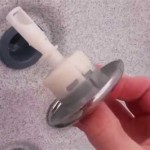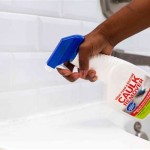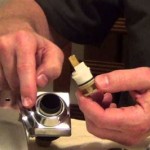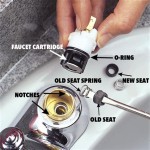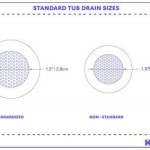Understanding Freestanding Bathtub Drain Kits
Freestanding bathtubs have become increasingly popular due to their elegant design and ability to serve as a focal point in bathroom spaces. Unlike traditional bathtubs that are integrated into walls or platforms, freestanding tubs stand alone, requiring a specific type of drain connection. This necessitates the use of a freestanding bathtub drain kit, a specialized plumbing component designed to effectively and aesthetically manage water drainage from these tubs.
A freestanding bathtub drain kit is more than just a standard drain; it incorporates several crucial elements that accommodate the unique installation requirements of a freestanding tub. These kits are engineered to connect the tub's drain outlet to the existing plumbing infrastructure within the floor, often with concealed or visually appealing exposed piping. Selection and proper installation of a freestanding bathtub drain kit are essential for a functional and visually appealing bathroom.
The purpose of this article is to provide a comprehensive overview of freestanding bathtub drain kits. This exploration encompasses the different types of kits available, the components included, factors to consider during selection, installation procedures, and troubleshooting common issues. By understanding these aspects, individuals can make informed decisions and ensure a successful freestanding bathtub installation.
Key Components of a Freestanding Bathtub Drain Kit
A freestanding bathtub drain kit typically consists of several interconnected components, each playing a vital role in the overall drainage system. Understanding these components is crucial for selecting the right kit and ensuring proper installation.
The tailpiece is a pipe that connects directly to the drain opening at the bottom of the bathtub. It is usually made of brass or PVC and often includes a rubber washer or gasket to create a watertight seal between the tailpiece and the bathtub. Threading or a compression fitting usually secures this connection.
The waste and overflow assembly (W&O) is an integral part of the drain system. It has two primary functions: to drain the water from the tub and to prevent the tub from overflowing. The overflow component is a vertical pipe connected to an opening near the top of the tub, allowing excess water to be channeled into the drain system if the water level rises too high. The waste portion connects to the tailpiece and directs the water towards the drainpipe.
The drainpipe, typically made of PVC or ABS, is the pipe that carries the wastewater away from the bathtub. This pipe connects to the W&O assembly and runs under the floor to connect to the main drain line of the plumbing system. The material and diameter of the drainpipe are important considerations, as they must comply with local plumbing codes and ensure adequate drainage capacity. Flexible drainpipes are sometimes used in freestanding installations to easily adapt to any spatial requirement and to improve the accessibility of the drainpipe.
A trap is a U-shaped or P-shaped section of pipe designed to hold a small amount of water. This trapped water creates a seal that prevents sewer gases from backing up into the bathroom, thus maintaining air quality. The trap is installed along the drainpipe, typically underneath the floor, and is a required component in all plumbing systems. The trap arm is the horizontal section of pipe extending from the trap to the main drain line.
The escutcheon is a decorative flange or cover that conceals the drain opening in the floor. It enhances the aesthetics of the installation by covering any visible plumbing connections. Escutcheons are available in various finishes and styles to match the bathtub and bathroom décor.
Types of Freestanding Bathtub Drain Kits
Several types of freestanding bathtub drain kits are available, each designed for specific installation requirements and aesthetic preferences. The selection of the appropriate kit depends on factors such as the bathtub's design, the location of the drain, and the desired visual appearance.
Exposed freestanding bathtub drain kits are designed to be visible, showcasing the plumbing connections as part of the bathroom's design. These kits often feature polished metal pipes, such as chrome or brushed nickel, and are intended to create a modern or industrial look. Exposed kits require careful attention to detail during installation, as all connections and fittings are visible.
Concealed freestanding bathtub drain kits are designed to hide the plumbing connections under the floor, providing a cleaner and more minimalist look. These kits typically use flexible drainpipes to connect the bathtub's drain to the existing plumbing infrastructure. Concealed kits require more extensive planning and may involve cutting into the floor to make the necessary connections.
A center drain kit positions the drain in the center of the bathtub's bottom. This type of kit is suitable for bathtubs with center drain openings. The drain kit components are designed to align with the center drain location, ensuring proper water flow and drainage.
An end drain kit, in contrast, is designed for bathtubs with drain openings located at one end. This type of kit requires careful consideration of the placement of the drainpipe and the W&O assembly to ensure the proper connection and drainage.
A waste and Overflow drain kit integrates both the waste and overflow functions into a single unit. It is connected to the drainpipe, allowing water to drain from the tub and preventing overflow. The W&O kit is suitable for various bathtub types, and several designs can accommodate different aesthetic preferences.
Factors to Consider When Selecting a Freestanding Bathtub Drain Kit
Choosing the right freestanding bathtub drain kit involves considering several factors to ensure compatibility, functionality, and aesthetics. A thorough evaluation of these factors can prevent installation issues and ensure a long-lasting, reliable drainage system.
Compatibility refers to the ability of the drain kit to work effectively with the bathtub. This includes ensuring the tailpiece fits the drain opening, the drainpipe diameter matches the existing plumbing, and the W&O assembly aligns correctly with the overflow opening. It is essential to check the specifications of both the bathtub and the drain kit to confirm compatibility before purchase.
The material of the drain kit components is another crucial consideration. Brass is a durable and corrosion-resistant material commonly used for tailpieces, W&O assemblies, and escutcheons. PVC and ABS are lightweight and cost-effective materials often used for drainpipes. The choice of material depends on factors such as budget, desired durability, and local plumbing codes.
The finish of the exposed components, such as the escutcheon and the exposed pipes (in exposed kits), should match the bathroom's décor. Common finishes include chrome, brushed nickel, oil-rubbed bronze, and matte black. Coordinating the finish of the drain kit with the bathtub faucet, showerhead, and other bathroom fixtures can greatly enhance the overall aesthetic appeal.
Local plumbing codes dictate the requirements for materials, pipe sizes, and installation procedures. It is essential to consult local plumbing codes before selecting and installing a freestanding bathtub drain kit. Compliance with these codes ensures the safety, functionality, and legality of the plumbing installation. These codes also generally dictate the trap size and type.
Budget constraints also have a significant impact on the selection of a drain kit. Prices vary depending on the type of kit, the materials used, and the brand, and you want to set a budget.
Installation Procedures for Freestanding Bathtub Drain Kits
Installing a freestanding bathtub drain kit is a multi-step process that requires careful attention to detail and adherence to manufacturer's instructions. The following steps provide a general overview of the installation process. However, always consult the specific instructions included with the drain kit and local plumbing codes before proceeding.
Begin by gathering all the necessary tools and materials, including the drain kit, pipe wrench, adjustable wrench, plumber's tape, screwdriver, level, measuring tape, and safety glasses. Ensure the work area is clean and well-lit. Review the drain kit instructions to familiarize yourself with the components and the installation sequence. Turn off the water supply to the bathroom before starting any plumbing work.
The first step is to install the tailpiece into the drain opening at the bottom of the bathtub. Apply plumber's tape to the threads of the tailpiece to create a watertight seal. Insert the tailpiece into the drain opening and tighten it securely using a pipe wrench. Ensure the tailpiece is aligned correctly and does not wobble. Place the rubber washer between the tailpiece and the tub to provide a watertight seal.
Connect the W&O assembly to the tailpiece and the overflow opening. Ensure all connections are tight and secure. If the kit includes flexible pipes, carefully route them to minimize bends and kinks. Tighten all connections, ensuring no leaks.
Connect the drainpipe to the W&O assembly and route it toward the main drain line. Measure and cut the drainpipe to the appropriate length using a pipe cutter. Apply PVC or ABS glue to the connections and join the pieces together, following the glue manufacturer's instructions. Support the drainpipe as needed to ensure proper alignment.
Install the trap along the drainpipe, ensuring it is properly aligned and connected. Use pipe clamps or straps to secure the trap in place. Ensure the trap arm extends far enough to connect to the main drain line. The trap creates a water seal that prevents sewer gases from entering the bathroom.
Connect the drainpipe to the main drain line using appropriate fittings, such as elbows or tees. Ensure all connections are tight and secure. Use plumber's tape or pipe joint compound to create watertight seals. Double-check all connections to prevent leaks. Install the escutcheon over the drain opening in the floor to conceal the connections.
After completing the installation, turn the water supply back on and check for leaks. Run water into the bathtub and observe the drainage. Inspect all connections for drips or seepage. If leaks are detected, tighten the connections or replace any faulty components. Use a level to ensure the bathtub is properly aligned and the water drains correctly.
Troubleshooting Common Issues with Freestanding Bathtub Drain Kits
Even with careful installation, issues can arise with freestanding bathtub drain kits. Understanding common problems and their solutions can help troubleshoot and resolve these issues effectively.
One common problem is leaks, which can occur at various points in the drain system, such as at the tailpiece, the W&O assembly, or the drainpipe connections. To resolve leaks, first, identify the source of the leak. Tighten the connections using a pipe wrench, ensuring not to overtighten and damage the components. If tightening does not resolve the leak, disassemble the connection and reapply plumber's tape or pipe joint compound. Replace any damaged or worn-out washers or gaskets.
A clogged drain can impede water flow and cause the bathtub to drain slowly. To clear a clog, use a plunger to create suction and dislodge the blockage. If a plunger is ineffective, try using a drain snake or auger to break up or remove the clog. Chemical drain cleaners can also be used, but follow the manufacturer's instructions carefully to avoid damaging the pipes. In severe cases, it may be necessary to disassemble the drain system to manually remove the clog.
Sewer gas odors can be caused by a dry or improperly installed trap. Ensure the trap is properly installed and filled with water. If the odor persists, check for leaks in the drainpipe or the connections to the main drain line. Seal any leaks with plumber's tape or pipe joint compound. Replacing the trap may be necessary if it is damaged or corroded.
If the bathtub is not draining properly, ensure the drain stopper is fully open and not obstructing the water flow. Check the overflow opening for any debris or obstructions. Remove any blockages to ensure proper drainage. Ensure the bathtub is level, otherwise, water will pool at one end, and the draining will be affected.
Noisy drain pipes can be caused by air trapped in the drain system or by pipes that are not properly secured. Secure the drainpipes with pipe clamps or straps to prevent them from vibrating. Insulate the pipes to reduce noise transmission. Adding air vents to the drain system can help release trapped air and reduce noise.

Oatey Abs Freestanding Tub Drain Kit 46001a

Pvc Quick Connect Freestanding Tub Drain

Sioux Chief 819 2p Pvc Freestanding Tub Drain Kit

Maax F2 Drain Abs Kit For Freestanding Bathtub Installation 10032747 The Home Depot

Freestanding Tub Drain Rough In Kit Free Standing Kits For Bathtub Installation With Abs Pipe Brass Certification

Oatey 4 In Pvc Freestanding White Drain Overflow Kit With Brass Pipe Included The Bathtub Drains Department At Com

Oatey Abs Freestanding Tub Drain Kit 46001a

Victoria Albert Freestanding Bathtub Drain For Above Floor Installation Box Polished Chrome K 50 Pc

Drop In Drain Carver Tubs

Freestanding Bathtub Drain Kit For Above Floor Installation Box Polished Brass
Related Posts

